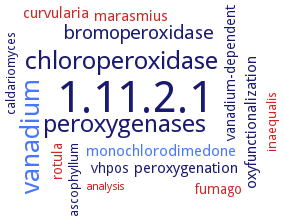1.11.2.1: unspecific peroxygenase
This is an abbreviated version!
For detailed information about unspecific peroxygenase, go to the full flat file.

Word Map on EC 1.11.2.1 
-
1.11.2.1
-
vanadium
-
chloroperoxidase
-
peroxygenases
-
bromoperoxidase
-
peroxygenation
-
marasmius
-
curvularia
-
monochlorodimedone
-
oxyfunctionalization
-
vanadium-dependent
-
rotula
-
fumago
-
vhpos
-
ascophyllum
-
inaequalis
-
caldariomyces
-
analysis
- 1.11.2.1
- vanadium
- chloroperoxidase
-
peroxygenases
-
bromoperoxidase
-
peroxygenation
- marasmius
- curvularia
- monochlorodimedone
-
oxyfunctionalization
-
vanadium-dependent
- rotula
- fumago
-
vhpos
-
ascophyllum
- inaequalis
-
caldariomyces
- analysis
Reaction
Synonyms
45 kDa peroxygenase/peroxidase, Agrocybe aegerita peroxidase, Agrocybe aegerita peroxidase/peroxygenase, Agrocybe aegerita peroxygenase, APO, aromatic peroxygenase, extracellular peroxygenase, haloperoxidase, haloperoxidase-peroxygenase, heme-thiolate peroxygenase, mushroom peroxygenase, P450st, PaDa-I, PII, unspecific heme peroxygenase, UPO, UPO-I, UPO-II, UPO1
ECTree
Advanced search results
Engineering
Engineering on EC 1.11.2.1 - unspecific peroxygenase
Please wait a moment until all data is loaded. This message will disappear when all data is loaded.
F88L
T158F
F12Y/A14V/R15G/A21D/V57A/L67F/V75I/I248V/F311L
F12Y/A14V/R15GA21D/V57A/L67F/V75I/I248V/F311L
this mutant retains strong activity and stability, particularly in terms of temperature and the presence of co-solvents, compared to the wild type enzyme
G241D/R257K
the mutant displays a 2fold improvement in peroxygenase activity and half the peroxidative activity of the wild type enzyme
S226G
the mutant shows increased thermal stability compared to the wild type enzyme
T120V/S226G/T320N
the mutant shows reduced activity compared to the wild type enzyme
T120V/S226G/T320R
the mutant shows reduced activity compared to the wild type enzyme
F310A/A320Q
A161L
-
the mutant substantially diminishes the 4- and 3-octanol formation from octane while preserving the 2-octanol regioisomer formation as compared to the wild type enzyme
F154V
-
the mutant demonstrates 1.8fold improved turnover numbers for formation of the 4-octanol regioisomer relative to the wild type enzyme. Also, a 1.5 and 4fold decreased formation of 3- and 2-octanol, respectively, are observed
F59Q/L60F/S159G
-
the mutant shows 2.6fold improved conversion efficiency with 5-nitro-1,3-benzodioxole as compared to the wild type enzyme
F59Q/L60M/S159G/F154A
-
the mutant shows 2.7fold improved conversion efficiency with 5-nitro-1,3-benzodioxole as compared to the wild type enzyme
L60A
-
the mutation almost abolishes the octane transformation but keeps a significant cyclohexene oxide formation compared to the wild type enzyme
L60F
-
the mutant shows 2.7fold improved conversion efficiency with 5-nitro-1,3-benzodioxole as compared to the wild type enzyme
L60F/F154I
-
the mutant shows 1.2fold improved conversion efficiency with 5-nitro-1,3-benzodioxole as compared to the wild type enzyme
L60F/F154V
-
the mutant shows 1.2fold improved conversion efficiency with 5-nitro-1,3-benzodioxole as compared to the wild type enzyme
L60F/S159G/A161F
-
the mutant shows 2.9fold improved conversion efficiency with 5-nitro-1,3-benzodioxole as compared to the wild type enzyme
L60M
-
the mutant shows 1.2fold improved conversion efficiency with 5-nitro-1,3-benzodioxole as compared to the wild type enzyme
L60Q
-
the mutant shows 1.3fold improved conversion efficiency with 5-nitro-1,3-benzodioxole as compared to the wild type enzyme
-
the mutant shows reduced mono-epoxide production compared to the wild type enzyme
F88L
-
the mutation strongly increases the enzyme's catalytic efficiency in oxidizing veratryl alcohol (21fold), benzyl alcohol (11fold), and naphthalene (5fold) compared to the wild type enzyme
-
the mutant shows increased mono-epoxide production compared to the wild type enzyme
T158F
-
the variant improves the oxidation only of benzyl alcohol but decreases the oxidation of veratryl alcohol and naphthalene compared with the wild type enzyme
the mutant enzyme exhibits enhanced activity, secretion and stability compared to the wild type enzyme
F12Y/A14V/R15G/A21D/V57A/L67F/V75I/I248V/F311L
the variant carries nine mutations that enhance its activity in the presence of 30% acetonitrile (v/v) up to 23fold over parental type. The mutant is also active and stable in aqueous acetone, methanol and dimethyl sulfoxide mixtures
-
specific activity of peroxygenase is significantly increased over a broad pH-range. The pH dependence of the reaction is altered to bell shaped, with maximum activities near pH 5. At pH 5, the mutant is over 15 times more active than wild-type P450st
F310A/A320Q
site-directed mutagenesis, the mutant exhibits a 30 mV positive shift in redox potential for the FeIII/FeII couple compared with wild-type P450st due to weakening of the electron-donating effect (push effect) of the proximal thiolate in the mutant. This result indicates that the electron density around the heme is decreased, and thus the Lewis acidity of the heme is expected to be increased. Mutant F310A/A320Q maintains higher thermal stability than typical P450s
F310A/A320Q
-
specific activity of peroxygenase is significantly increased over a broad pH-range. The pH dependence of the reaction is altered to bell shaped, with maximum activities near pH 5. At pH 5, the mutant is over 15 times more active than wild-type P450st
-
F310A/A320Q
-
site-directed mutagenesis, the mutant exhibits a 30 mV positive shift in redox potential for the FeIII/FeII couple compared with wild-type P450st due to weakening of the electron-donating effect (push effect) of the proximal thiolate in the mutant. This result indicates that the electron density around the heme is decreased, and thus the Lewis acidity of the heme is expected to be increased. Mutant F310A/A320Q maintains higher thermal stability than typical P450s
-


 results (
results ( results (
results ( top
top






